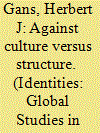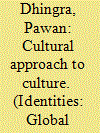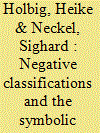|
|
|
Sort Order |
|
|
|
Items / Page
|
|
|
|
|
|
|
| Srl | Item |
| 1 |
ID:
113867


|
|
|
|
|
| Publication |
2012.
|
| Summary/Abstract |
Contemporary sociology is saddled with a culture-structure binary but the fault for its existence lies mostly with cultural sociology. This article is devoted to four related assertions: (1) There has never been any agreement on the definition of culture, making cultural sociology a field unable to define its central concept. (2) The binary ignores the fact that the proper explanation of social behaviour requires both structure and culture; culture cannot be its own cause. (3) Cultural sociology is soft and sentimental, avoiding conflict as well as politics. (4) It neglects policy and policy-relevant research even more than the rest of sociology. Structural sociology has some shortcomings as well, however, and the culture-structure binary should be abandoned.
|
|
|
|
|
|
|
|
|
|
|
|
|
|
|
|
| 2 |
ID:
174601


|
|
|
|
|
| Summary/Abstract |
Drawing on interviews with thirty-two black British professionals, and ethnographic work in middle-class cultural spaces across London, this paper asks ‘How do the black middle-class use cultural consumption for anti-racism?’ I argue that the black middle-class contest the racial hierarchy at three levels through their cultural consumption: the material, the ideological, and the symbolic. At the material level, black middle-class people consume cultural forms they decode as ‘white’ in order to establish an equity with whites in levels of cultural capital. At the ideological level, black middle-class people consume cultural forms that uplift meanings and representations of blackness, thus challenging controlling images of blackness. Lastly, at the symbolic level, black middle-class folks create and sustain cultural spaces where black people’s cultural and symbolic knowledge is given proper recognition and authority.
|
|
|
|
|
|
|
|
|
|
|
|
|
|
|
|
| 3 |
ID:
151739


|
|
|
|
|
| Summary/Abstract |
Artifacts and Allegiances: How Museums Put the Nation and the World on Display takes a global approach to how museums make sense of increased globalization and migration. Museums construct narratives that link their locality to the nation and to the world. Peggy Levitt’s major book explains how museums imagine themselves and how they work towards composing a kind of visitor experience. It is about museum visions, missions, and exhibitions as told through the eyes of those who create and are responsible for them, namely, top administrators, curators, politicians, and more. Her analysis explains why museums only a few hundred miles apart can have such different conceptions of how to create the proper citizen. As such, the book illuminates the power of a cultural sociological approach.
|
|
|
|
|
|
|
|
|
|
|
|
|
|
|
|
| 4 |
ID:
116587


|
|
|
|
|
| Publication |
2012.
|
| Summary/Abstract |
The focal point of this article is identity as potentiality: how a narrated form of self-understanding can be mobilised, enacted and shared with others within unequally distributed multifaceted conditions of existence, with other outcomes than surrender to disowned and self-confirming actions of reproduced exclusion, subordination and enclosure. Concretely, this distribution demonstrates how and why identity as potentiality might come into being within the play of forces in the life of a young Muslim woman trying to incorporate herself into Swedish multicultural society. In addition, the reader will meet reflections on respectability, multicultural incorporation and the possibility of a non-injurious criticism.
|
|
|
|
|
|
|
|
|
|
|
|
|
|
|
|
| 5 |
ID:
146637


|
|
|
|
|
| Summary/Abstract |
This article explains a cultural sociological approach to research on social inequality. “Cultural sociological” means that we do not regard social inequality as resulting only from a distributive order of goods, income and positions, but also from an evaluative order created and reproduced by the actions of social groups. Concerning the topic of this thematic issue, this means that, from a sociological perspective, we see “weakness” not only as the social vulnerability of actors and groups resulting from a lack of material resources, education and power, but also as an attribution and assessment which can have a variety of social consequences. “Weakness” can compel others to help the weak and defend their interests. But if the weak are to be protected and empowered, they must be identified as “weak” in the first place, and this act of identification can have paradoxical consequences. As we demonstrate with evidence from East Asia, the social designation as “weak” can have many adverse effects for the weak groups themselves, because it blames them for their own weaknesses and publicly condemns, disparages, or stigmatizes them. Based on an analysis of the situation of victims of the Fukushima disaster in Japan and of rural migrants and their offspring living in Chinese metropoles, we show how social designations of weakness can produce negative classifications that signal disrespect to weak actors and limit their opportunities for action.
|
|
|
|
|
|
|
|
|
|
|
|
|
|
|
|
|
|
|
|
|